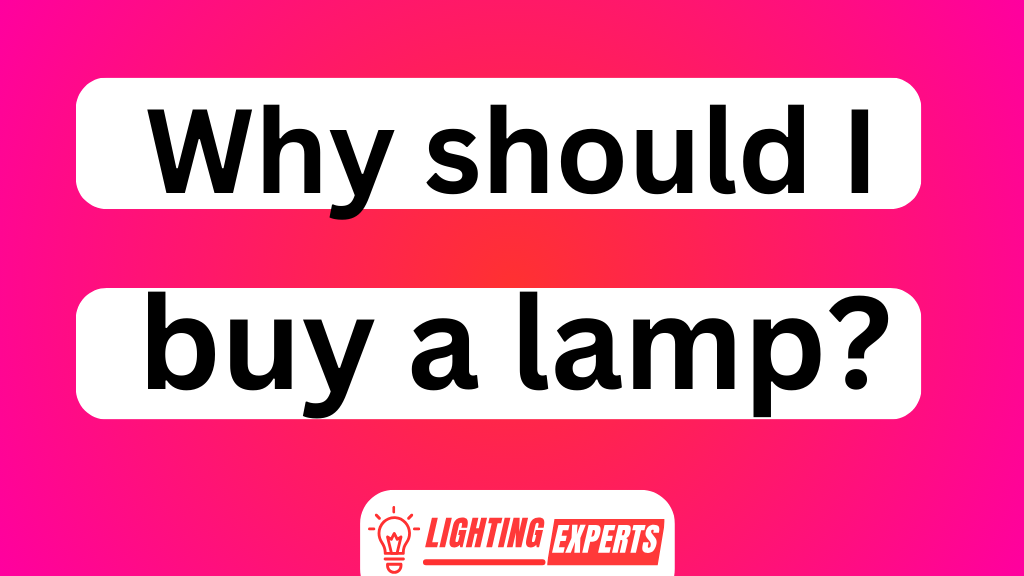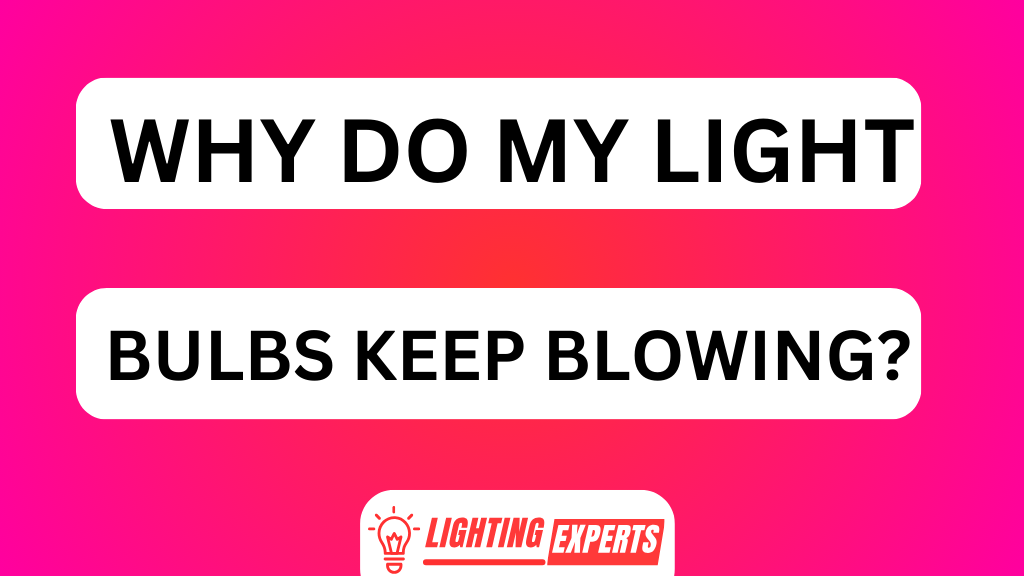When raising chicks, it is crucial to provide them with the right amount of heat to ensure their survival and development. But how long do chicks actually need a heat lamp? This question often plagues new poultry owners, causing anxiety and uncertainty.
Fear not! In this article, we will explore the factors that determine the duration of heat lamp usage for chicks, including optimal temperatures during different stages and signs that indicate they no longer require the warmth.
By the end, you’ll be equipped with all the knowledge needed to keep your feathered friends cozy and safe.
Key Takeaways HOW LONG DO CHICKS NEED HEAT LAMP
- The optimal temperature range for chicks during the first week is 90-95 degrees Fahrenheit.
- The heat lamp should be kept on continuously for the first few days, then gradually reduce the duration as the chicks grow older.
- Chicks that are too hot will move away from the heat source and pant, while chicks that are cold will huddle together and chirp loudly.
- As the chicks grow older, the height of the heat lamp should be increased and the heat source provided by the lamp should be gradually reduced.
Factors to Consider When Determining the Duration
When determining the duration, there are several factors to consider. One of the most important factors is maintaining an optimal temperature range for the chicks.
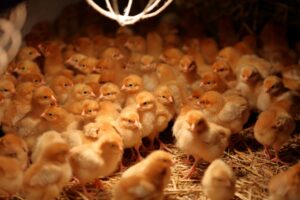
Chicks need a warm and consistent environment to thrive, especially during their early stages of life. The ideal temperature range for chicks is between 90-95 degrees Fahrenheit during the first week, gradually decreasing by five degrees each week until they are fully feathered and can regulate their own body temperature.
It is crucial to monitor temperature levels closely using a thermometer or heat lamp with adjustable settings to ensure that it remains within this range. Fluctuations in temperature can lead to developmental issues and even death in young chicks. Therefore, providing a consistent and appropriate heat source is vital for their growth and well-being.
Optimal Temperature for Chicks During Different Stages
Throughout their various stages, chicks thrive best under an optimal temperature with the help of a heat lamp. Maintaining the right temperature is crucial for their growth and development. Here are some key poi
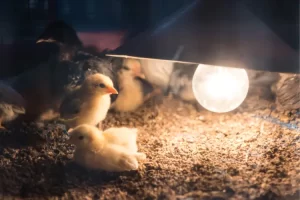
nts to consider regarding the optimal temperature range for chicks:
- The ideal temperature range for newly hatched chicks is between 95°F (35°C) and 100°F (38°C).
- As they grow, you can gradually decrease the temperature by around 5°F (3°C) each week until reaching room temperature.
- It’s important to monitor the chicks’ behavior to ensure they are comfortable. If they huddle together or chirp loudly, it might indicate that they are too cold.
- Alternatively, if they move away from the heat source or pant excessively, it could mean that they are too hot.
- Besides using a heat lamp, other alternatives such as heating pads or brooders can also provide sufficient warmth.
Understanding these optimal temperature ranges and alternative options will help ensure that your chicks remain healthy and thriving.
Now let’s explore how long to keep the heat lamp on during their first week of life.
How Long to Keep the Heat Lamp on During the First Week
To ensure the well-being of your newly hatched chicks during their first week, it’s important to consider the duration for which you should keep the heat lamp on.
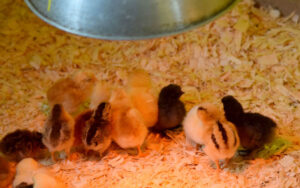
The optimal temperature range for chicks during their first week is between 95 and 100 degrees Fahrenheit. It is crucial to monitor chick behavior closely to determine if they are comfortable or in need of additional warmth.
Chicks that are too hot will move away from the heat source and pant, while those that are cold will huddle together and chirp loudly.
Initially, it is recommended to keep the heat lamp on continuously for the first few days after hatch, gradually reducing the duration as chicks become better able to regulate their body temperature.
Adjusting the Heat Lamp as Chicks Grow Older
As chicks grow older, it becomes necessary to make adjustments to their heat lamp setup. One key point is increasing the height of the heat lamp as the chicks become more mobile and active. This allows them to regulate their own body temperature and prevents overheating.
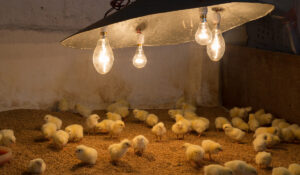
Another important consideration is gradually reducing the heat source provided by the lamp, mimicking natural conditions and encouraging the chicks’ independence and resilience.
Increasing Heat Lamp Height
Raising the heat lamp height can help regulate the temperature for growing chicks. As chicks grow older, they require a slightly lower temperature to ensure their comfort and health. Increasing the distance between the heat lamp and the chicks can effectively increase the temperature in their environment. Here are some key points to consider when adjusting the heat source:
- Gradually raising the height of the heat lamp allows for a gradual increase in temperature.
- Regularly monitor chick behavior and adjust accordingly.
- Maintain a thermometer within reach to accurately measure temperature changes.
- Provide shaded areas within their living space to allow chicks to regulate their body temperature naturally.
- Ensure proper ventilation in order to prevent overheating.
By following these guidelines, you can safely increase the temperature for growing chicks while maintaining optimal conditions for their development. This will lay a solid foundation for them as they continue to mature.
Now let’s explore how gradually reducing the heat source is an essential step in this process.
Gradually Reducing Heat Source
As chicks grow older, their need for a constant heat source gradually decreases. After adjusting the height of the heat lamp to maintain a comfortable temperature, it is important to start reducing the intensity of the heat source over time. This gradual temperature adjustment helps chicks acclimate to their surroundings and develop their natural ability to regulate body temperature.
To monitor chick behavior during this process, observe how they respond to changes in temperature. If they huddle together directly under the heat source or appear restless and uncomfortable, it may be an indication that they still require more warmth. On the other hand, if chicks are spending less time under the heat lamp and are actively exploring their environment without signs of distress, it is a positive sign that they are adapting well and can tolerate lower temperatures.
Signs That Chicks No Longer Need the Heat Lamp
Feather growth indicates that chicks no longer need the heat lamp. As their feathers begin to develop, they become better equipped to regulate their own body temperature and stay warm without relying on external sources of heat.
Additionally, active exploration behaviors such as venturing away from the heat lamp and exploring their surroundings indicate that chicks are becoming more independent and capable of handling cooler temperatures.
Lastly, if chicks are comfortable without huddling together under the heat lamp and instead spread out across the brooder, it is a strong indication that they no longer require supplemental heat.
Feather Growth Indicates
To determine when chicks no longer require a heat lamp, you can look at their feather growth. As chicks develop, their feathers go through different stages of growth, indicating their readiness to regulate their own body temperature.
Here are some signs that feather development is progressing and the duration of heat lamp usage may be coming to an end:
- Primary feathers start to replace down feathers
- Wing feathers become visible and begin to cover the wings
- Tail feathers begin to grow in length
- Feathers on the chest and back become more dense and fully developed
- Chicks exhibit increased preening behavior
These changes in feather development suggest that chicks are becoming better equipped to maintain their body heat without relying on the heat lamp. As they continue to grow and explore their environment, they will also display active exploration behaviors.
Active Exploration Behaviors
Feather growth is an essential milestone in a chick’s development. As their feathers grow, chicks become more capable of regulating their own body temperature and are less reliant on external sources of warmth like heat lamps. This increased independence allows them to engage in active exploration behaviors.
Once they have sufficient feather coverage, chicks can venture further from the heat source without risking hypothermia. Active exploration is crucial for their physical and mental development as it helps them build strength, coordination, and social skills. Chicks will start to hop, fly short distances, peck at objects, and interact with their surroundings more enthusiastically.
It is important to provide a safe environment that encourages these exploratory behaviors while ensuring that the chicks remain protected from any potential dangers or predators.
Comfortable Without Huddling
You’ll notice that as their feathers continue to grow, chicks become more comfortable without huddling together for warmth. This is a natural progression in their behavior as they develop and adapt to their environment.
As chicks grow older and gain more feathers, they are better equipped to regulate their body temperature and maintain comfort on their own.
Here are some key points about chicks’ behavior and optimal temperature:
- Chicks start to exhibit independent behaviors, exploring their surroundings more actively.
- They spread out from each other during the day but may still choose to sleep close together at night.
- Chicks will seek areas of optimal temperature within their environment.
- It’s important to provide a warm spot in the brooder so that chicks can regulate their body temperature effectively.
- Monitoring the ambient temperature is crucial to ensure that it remains within the recommended range for chicks’ growth and development.
Transitioning Chicks to Living Without a Heat Lamp
Once your chicks reach about six weeks old, they can start transitioning to living without a heat lamp. At this stage, their feathers are fully grown and provide enough insulation to keep them warm.
The process of weaning them from the heat lamp involves gradually decreasing the temperature in their brooder. Start by raising the heat lamp a few inches higher each day until it is no longer needed. It’s important to monitor the chicks during this transition period to ensure they are comfortable and not experiencing any signs of distress or cold stress.
Keep an eye out for huddling behavior or shivering, as these may indicate that they still need additional warmth. By slowly acclimating them to room temperature, you can ensure a smooth and safe transition for your growing chicks.
Transitioning chicks from relying on a heat lamp to living without one is an essential step in their development and self-regulation of body temperature. However, ensuring their safety during this phase is crucial.
Ensuring the Chicks’ Safety During the Heat Lamp Phase
Ensuring the safety of your chicks during the transition phase from relying on a heat lamp to living without one is crucial. As the chicks become more independent, it’s important to maintain an optimal temperature in their brooder.
Here are some key tips for keeping your chicks safe during this critical period:
- Regularly monitor the temperature inside the brooder using a reliable thermometer.
- Gradually reduce the height of the heat lamp over time, mimicking natural sunlight and allowing the chicks to acclimate.
- Provide adequate ventilation to prevent overheating and ensure fresh air circulation.
- Keep a close eye on any signs of distress or discomfort in your chicks, such as panting or huddling together excessively.
- Consider using alternative sources of warmth, such as heating pads or radiant heaters, if you decide to remove the heat lamp completely.
Frequently Asked Questions
How Often Should I Check the Temperature Under the Heat Lamp?
To ensure consistent temperature, it is important to frequently check the temperature under the heat lamp. Signs of overheating or underheating should be monitored closely to provide optimal conditions for the chicks.
Can I Use a Regular Light Bulb Instead of a Heat Lamp for the Chicks?
Using a regular light bulb as an alternative to a heat lamp for chicks can be risky. While it may provide some warmth, it doesn’t emit the necessary infrared heat needed for their growth and development.
What Should I Do if the Chicks Are Huddling Together Under the Heat Lamp?
If the chicks are huddling together under the heat lamp, it may indicate that they are too cold. They should be kept warm and comfortable to ensure their well-being. Consider using alternative methods like a brooder or heating pad.
Are There Any Risks of Using a Heat Lamp for the Chicks?
There are risks of overheating when using a heat lamp for chicks, such as burns or fires. It is important to monitor the temperature closely. Alternative heating methods like brooders or radiant heaters can be safer options.
Can I Use a Brooder Plate Instead of a Heat Lamp for the Chicks?
A brooder plate is a great alternative to a heat lamp for chicks. It provides warmth while minimizing the risk of fire and overheating. The benefits of using a brooder plate include improved safety and reduced energy consumption.
Conclusion
In conclusion, determining how long chicks need a heat lamp is crucial for their well-being. By considering factors such as temperature, age, and behavior, you can ensure that they are kept warm and comfortable during their early stages of life.
While some may argue that chicks can adapt to cooler temperatures sooner, it is important to prioritize their safety and gradual transition. By providing the necessary heat and monitoring their behavior closely, you can successfully raise healthy chicks without compromising their development.

